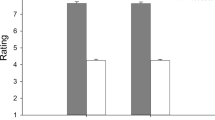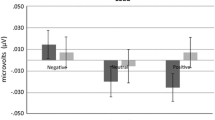Abstract
Shared representations, emotion comprehension, and emotion regulation constitute the basic macro components of social empathy. The present study integrated two different measures of empathic behavior in a social context: verbal self-report measures (empathic response, emotional involvement and emotional significance, and valence), and autonomic responses (facial expression-corrugator supercilii and zygomaticus major muscle-, SCR—skin conductance-, and HR—heart rate-). Participants (N = thirty-five) were presented with different interpersonal scene types (cooperation, non-cooperation, conflict, indifference). Different empathic sensitivity to these interpersonal situations was verified, since self-rating on empathy, emotional involvement and valence varied as a function of interpersonal context. Situation rated as more empathically significant were considered also as the most positive (cooperation) and negative (non cooperation and conflictual) and emotionally significant (high emotional significance of the scenes) in comparison with neutral scenes. Nevertheless, subjective empathic response and personal emotional involvement were found to be dissociated measures in non-cooperative condition. On the autonomic level, facial mimicry was linked to and coherent with the empathic response in cooperative, non-cooperative and conflictual conditions, whereas SCR and HR were increased only in response to cooperative and conflictual situation, rated as more involving by the subject. The convergence of these multidimensional measures was discussed: empirical evidences are far from able to warrant claims that processes of emotional contagion and simulation provide the sole, primary important way by which we come to know what others are feeling.



Similar content being viewed by others
References
Amrhein, C., Muhlberger, A., Pauli, P., & Wiedermann, G. (2004). Modulation of event-related brain potentials during affective picture processing: A complement to startle reflex and skin conductance response? International Journal of Psychophysiology, 54, 231–240.
Andrèasson, P., & Dimberg, U. (2008). Emotional empathy and facial feedback. Journal of Nonverbal Behavior, 32, 215–224.
Balconi, M., & Bortolotti, A. (2012). Resonance mechanism in empathic behavior. BEES, BIS/BAS and psychophysiological contribution. Physiology & Behavior, 105, 298–304.
Balconi, M., & Bortolotti, A. (in press). Detection of the facial expression of emotion and self-report measures in empathic situations are influenced by sensorimotor circuit inhibition by low-frequency rTMS. Brain Stimulation.
Balconi, M., & Lucchiari, C. (2005). In the face of emotions: Event-related potentials in supraliminal and subliminal facial expression recognition. Genetic, Social, and General Psychology Monographs, 131, 41–69.
Balconi, M., & Lucchiari, C. (2008). Consciousness and arousal effects on emotional face processing as revealed by brain oscillations. A gamma band analysis. International Journal of Psychophysiology, 67, 41–46.
Balconi, M., & Pozzoli, U. (2007). Event-related oscillations (ERO) and event-related potentials (ERP) comparison in facial expression recognition. Journal of Neuropsychology, 1, 283–294.
Balconi, M., & Pozzoli, U. (2009). Arousal effect on emotional face comprehension. Frequency band changes in different time intervals. Physiology & Behavior, 97, 455–462.
Balconi, M., Brambilla, E., & Falbo, L. (2009). Appetitive vs. defensive responses to emotional cues. Autonomic measures and brain oscillation modulation. Brain Research, 1296, 72–84.
Balconi, M., Bortolotti, A., & Gonzaga, L. (2011). Emotional face recognition, EMG response, and medial prefrontal activity in empathic behavior. Neuroscience Research, 71, 251–259.
Blumenthal, T. D., Cuthbert, B. N., Filion, D. L., Hackley, S., Lipp, O. V., & Van Boxtel, A. (2005). Committee report: Guidelines for human startle eyeblink electromyographic studies. Psychophysiology, 42, 1–15.
Bradley, M., & Lang, P. J. (2006). Emotion and motivation. In J. T. Cacioppo, L. G. Tassinary, & G. Berntson (Eds.), Handbook of psychophysiology (3rd ed., pp. 581–607). New York: Cambridge University Press.
Bradley, M. M., Codispoti, M., Cuthbert, B. N., & Lang, P. J. (2001). Emotion and motivation I: Defensive and appetitive reactions in picture processing. Emotion, 1, 276–298.
Brown, L. M., Bradley, M. M., & Lang, P. J. (2006). Affective reactions to pictures of ingroup and outgroup members. Biological Psychology, 71, 303–311.
Chauhan, B., Mathias, C. J., & Critchley, H. D. (2008). Autonomic contributions to empathy: Evidence from patients with primary autonomic failure. Autonomic Neuroscience, 140, 96–100.
Decety, J., & Jackson, P. L. (2004). The functional architecture of human empathy. Behavioral and Cognitive Neuroscience Reviews, 3, 71–100.
Decety, J., & Jackson, P. L. (2006). A social neuroscience perspective on empathy. Current Directions in Psychological Science, 15, 54–58.
Decety, J., Jackson, P. L., & Brunet, E. (2007). The cognitive neuropsychology of empathy. In T. F. Farrow & P. W. Woodruff (Eds.), Empathy in mental illness and health (pp. 239–260). Cambridge: Cambridge University Press.
Eisenberg, N., Fabes, R. A., Miller, P. A., Fultz, J., Shell, R., Mathy, R. M., et al. (1989). Relation of sympathy and personal distress to prosocial behavior: A multimethod study. Journal of Personality and Social Psychology, 57, 55–66.
Ekman, P., & Friesen, W. V. (1976). Pictures of facial affect. Palo Alto: Consulting Psychologist Press.
Farrow, T. F. D., & Woodruff, P. W. R. (2007). Empathy in mental illness. Cambridge: Cambridge University Press.
Fridlund, A. J., & Cacioppo, J. T. (1986). Guidelines for humans electromyographic research. Psychophysiology, 23, 567–589.
Gallese, V., & Goldman, A. (1998). Mirror neurons and the simulation theory of mind-reading. Trends Cogn Sci, 2, 493–501.
Harmon-Jones, E., & Winkielman, P. (2007). Social neuroscience: Integrating biological and psychological explanations of social behavior. New York: Guilford.
Hess, U., & Blairy, S. (2001). Facial mimicry and emotional contagion to dynamic emotional facial expressions and their influence on decoding accuracy. International Journal of Psychophysiology, 40, 129–141.
Hoffman, M. L. (1981). Is altruism part of human nature? Journal of Personality and Social Psychology, 40, 121–137.
Hooker, C. I., Verosky, S. C., Germine, L. T., Knight, R. T., & D’Esposito, M. (2008). Mentalizing about emotion and its relationship to empathy. Social, Cognitive, & Affective Neuroscience, 3, 204–217.
Ickes, W. J. (1997). Empathic accuracy. London: Guilford press.
Lamm, C., Porges, E. C., Cacioppo, J. T., & Decety, J. (2008). Perspective taking is associated with specific facial responses during empathy for pain. Brain Research, 1227, 153–161.
Lang, P. J., Greenwald, M. K., Bradley, M. M., & Hamm, A. O. (1993). Looking at pictures: Affective, facial, visceral and behavioral reactions. Psychophysiology, 30, 261–273.
Lee, T.-W., Dolan, R. J., & Critchley, H. D. (2008). Controlling emotional expression: Behavioral and neural correlates of nonimitative emotional responses. Cerebral Cortex, 18, 104–113.
Marci, C. D., & Orr, S. P. (2006). The effect of emotional distance on psychophysiologic concordance and perceived empathy between patient and interviewer. Applied Psychophysiology and Biofeedback, 31, 115–128.
Preston, S. D., & de Waal, F. B. (2002). Empathy: Its ultimate and proximate bases. Behavioral and Brain Sciences, 25, 49–71.
Preston, S. D., Bechara, A., Grabowski, T. J., Damasio, H., & Damasio, A. R. (2007). The neural substrates of cognitive empathy. Social Neuroscience, 2, 254–275.
Ruby, P., & Decety, J. (2004). How would you feel versus how do you think she would feel? A neuroimaging study of perspective taking with social emotions. Journal of Cognitive Neuroscience, 19, 988–999.
Shamay-Tsoory, S. G., Aharon-Peretz, J., & Perry, D. (2009). Two systems for empathy: A double dissociation between emotional and cognitive empathy in inferior frontal gyrus versus ventromedial prefrontal lesions. Brain, 132, 617–627.
Sonnby-Borgström, M. (2002). Automatic mimicry reactions as related to differences in emotional empathy. Scandinavian Journal of Psychology, 43, 433–443.
Westbury, R. W., & Neumann, D. L. (2008). Empathy-related responses to moving film stimuli depicting human and non-human animal targets in negative circumstances. Biological Psychology, 78, 66–74.
Xenia, A.-H., & Warden, D. (2007). Convergence between physiological, facial and verbal self-report measures of affective empathy in children. Infant and Child Development, 16, 237–254.
Yamada, M., & Decety, J. (2009). Unconscious affective processing and empathy: An investigation of subliminal priming on the detection of painful facial expressions. Pain, 143, 71–75.
Author information
Authors and Affiliations
Corresponding author
Rights and permissions
About this article
Cite this article
Balconi, M., Bortolotti, A. Empathy in Cooperative Versus Non-cooperative Situations: The Contribution of Self-Report Measures and Autonomic Responses. Appl Psychophysiol Biofeedback 37, 161–169 (2012). https://doi.org/10.1007/s10484-012-9188-z
Published:
Issue Date:
DOI: https://doi.org/10.1007/s10484-012-9188-z




